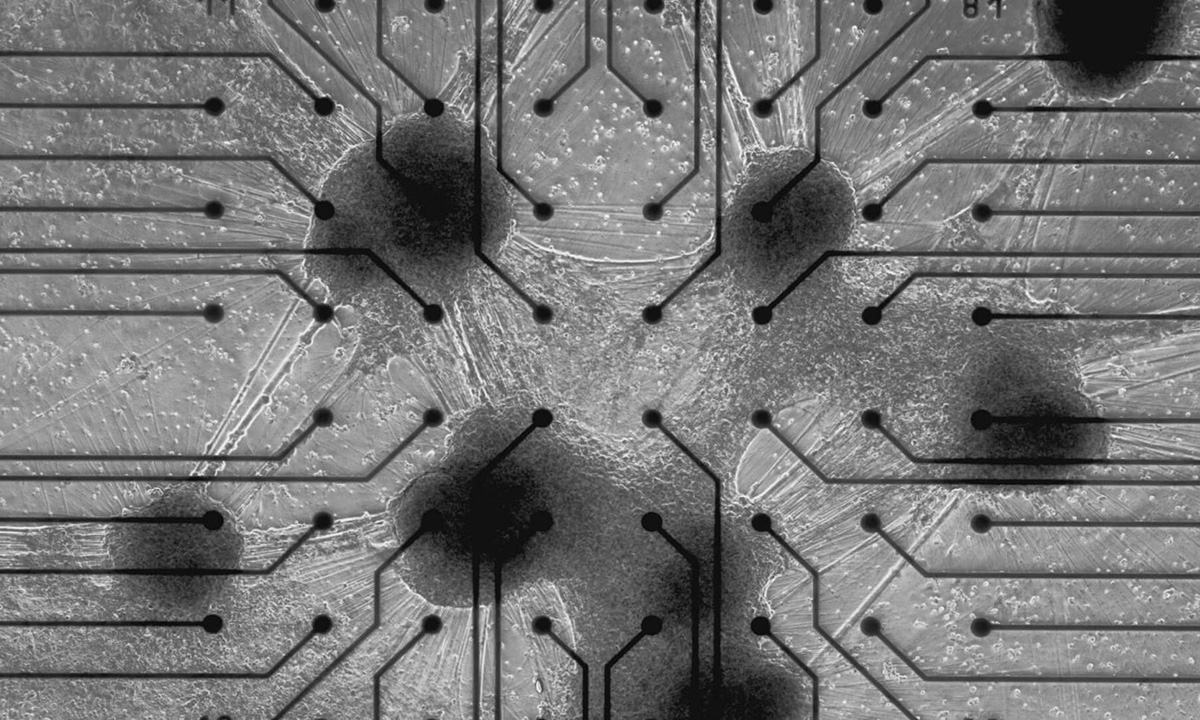Thanks to the activity by brain cells cultured in the laboratory, the CL1 computer learns very quickly, flexibly and energy saving.
Brett Kagan, Science Director at Cortical Labs, checked stem cells cultured in the laboratory. Image: New Atlas
Australian Cortical Labs launched CL1, the first biological computer in the world to combine human brain cells with silicon hardware to form a nerve nerve network, open a new era of AI technology. According to Cortical Labs, CL1 offers a completely new type of intelligence – more dynamic, more sustainable and more energy -saving than anyone existing.
Called the general biological intelligence (SBI), the CL1 system officially launched in Barcelona, Spain, on March 2, expected to become a turning point for scientific and medicine research. Basically, the artificial nerve network placed on the silicon chip is a constant organic computer evolved. The development engineer group said that it learned quickly and flexibly compared to the type of AI chip based on silicon used to train current linguistic models (LLM) today as chatgpt.
The potential of SBI will be revealed when the system reaches the user in the coming months, according to Hon Weng Chong, the founder and CEO of Cortical Labs. He said that customers can buy CL1 biological computers, or just buy time on chips, access them remotely to work with cultured cell technology through the cloud.
Brain cell biological computers can revolutionize everything, from detection of drugs, clinical trials to building “robot intelligence”, allowing personalization according to unlimited needs. CL1 is expected to be widely provided in the second half of this year.
Brain cells live on silicon chips between input/output electrodes. Image: Cortical Labs
In the CL1 system, the nerve cells cultured in the laboratory are placed on a flat and metal flat electrode sheet. Here, 59 electrodes form the basis of a more stable network, providing users with high levels of control when activating the nerve network. After that, this “SBI brain” was placed in a box that supports rectangular life, connected to the software system to operate in real time.
“A simple description is that it is like a body in the box, but there is a wave filter, some solvent storage places, a pump to maintain everything that circulate, mix gas and control temperature,” Brett Kagan, Science Director at Cortical Labs, explained.
In the laboratory, cortical is assembling boxes to create a first biological neuron server shelf of this type. Shelves contain 30 boxes, each containing many cells on the electrode sheet, expected to operate online in the next few months. The team aims to have 4 server shelves for commercial use through the cloud system before 2025 ends.
CL1 box does not need an external computer to operate. Image: Cortical Labs
A shelves containing CL1 boxes only use about 850 – 1,000 W energy. Each box costs about $ 35,000 and does not need an outside computer to operate. “We are aiming to significantly reduce costs and want to reduce prices in the long run. During that time, we will provide access to people from anywhere, any house, through the cloud system,” Kagan said.
“CL1 is the first commercial biological computer, uniquely designed to optimize communication and information processing with nerve cells cultured in test tubes. CL1, with an integrated life support system to maintain cell health, has great potential in the field of technology and medicine,” CL1 Development Group said.
“In essence, SBI is more natural than anyone because of using the same biological materials – neuron cells – as a basis for intelligence in living organisms.

Stock Market | Financial News | myMotherLode.com
rosarioh oneycutt · GitLab
Instant Love Spells – The Great Mkhulu Makenzi
Sweet Potatoes Gain Popularity as Nutrient-Dense and Sustainable Food Choice – 680 The Fan
How To Make A Concluding Paragraph For An Essay – PACI FERRO S.r.l.
MooreRoy | Law School Numbers
Newark, DE Window Replacement To Improve Home Energy Efficiency, Service Update – CENTRAL – NEWS CHANNEL NEBRASKA
ppaulleach | Experiment
What Should I Not Write My College Essay About – LEGIO MARIA TURKANA REGION
Rencanakan Hari Anda dengan Prakiraan Cuaca Akurat
Hadiah138: Situs Slot Online Terbaik Dengan Peluang Menang Tinggi
Profil – valhaley
Clearwater Apartment Moving Assistance For Seniors: Local Service Expands – KMLK
Skincare Brands US Market Entry Support: Business Registration, Marketing Update – 680 The Fan
AmpiCare Multichannel Content For Home Care & Assisted Living Centers Announced – CENTRAL – NEWS CHANNEL NEBRASKA
Stock Market | Financial News | myMotherLode.com
Profile of starlachurch
Dapatkan Cuaca Tamiang yang Akurat dengan Teknologi Canggih di Cuacaacehtamiang – membantu-penduduk-setempat
Certificate verification problem detected
digitalbusiness [licensed for non-commercial use only] / lilianmcwilliams
Clearwater Apartment Moving Assistance For Seniors: Local Service Expands – WICZ
What Was The Impact Of Exploration And Colonization On The Native Peoples Essay – Tobo Digital
ExpertEasy
Stock Market | Financial News | myMotherLode.com
Rahasia Sukses Para Bettor Slot Online Dalam Menang Jackpot – Ai blogs
Just a moment…
Laser-Engraved Glass Keepsake Box for Pro Photographers: Packaging Option Update – 680 The Fan
OdellPatrick < Main < NRAO Public Wiki
Best Beauty Products
https://myfreelancerbook.com/page/business-services/read-complete-guide